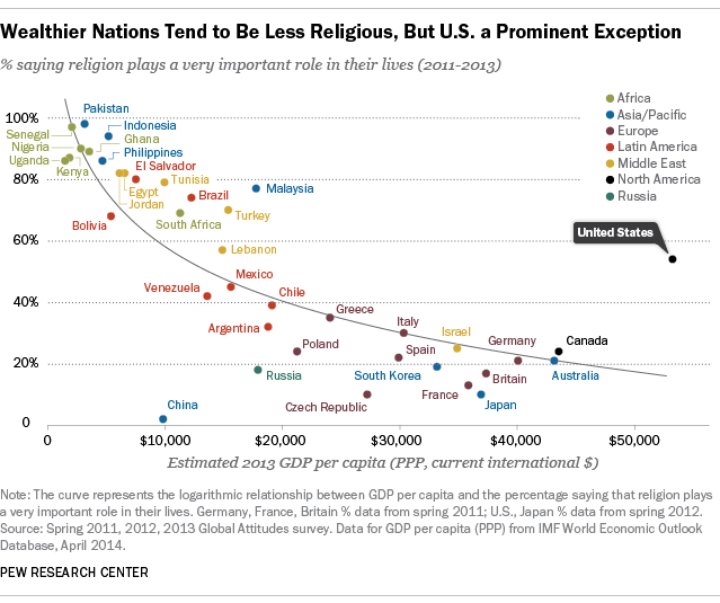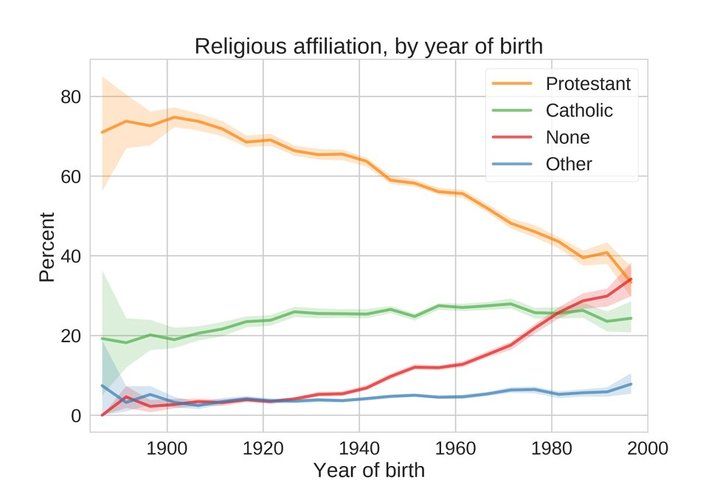… but she/he/it appears to be on the way out, in this country. We’re becoming less religious, with steep declines being seen by pollsters in the last two or three decades.

This graph, based on polls taken between 2011 and 2013, shows just how much of an outlier we are when it comes to religion. (Pew Research Center)
The so-called “Theory of Secularization” says that, as societies become more modern, their religiosity declines — “secularization” being decreased participation in organized religion along with loss of religious belief, including trust in religious authorities. As the graph shows, the theory works for virtually all the Western world — particularly in such highly-developed, progressive countries like Sweden, Norway, Denmark and even in the not-so-progressive United Kingdom. The United States has long been the outlier — as Probably Overthinking It blogger Allen Downey (Professor of Computer Science at Olin College, Massachusetts) puts it, “For more than a century, religion in the United States has defied gravity.”
Now we’re starting to catch up with the general Western-world decline. According to the University of Chicago’s General Social Survey (which surveys 1,000-2,000 adults in the US every year) the fraction of people who say they have no religious affiliation has increased from less than 10% to over 20% since the 1990s. At the same time, the fraction of those who say they “know God really exists and I have no doubts about it” is now 58%, down from 64%. And those who think the Bible is “an ancient book of fables, legends, history and moral precepts recorded by man” has jumped from 13% to 22%.

General Social Survey results from 1972, extrapolated to 2035 by Allen Downey. Used with permission. See his blog here.
I don’t want to get too excited about these numbers. After all, about two-thirds of Americans still identify as Christians, although the percentage of white Christians has almost halved, from 80% of the population in the 1970s to 43% today. How come? According to the Washington D.C.-based Public Religion Research Institute, (1) mainline, white denominations, including Presbyterians and Lutherans, have experienced sharp drops in membership; and (2) immigrant Latinos have contributed to Roman Catholic numbers (while the RC church, too, has lost white Catholics). Also, (3) white evangelicals — long a hard-core group of believers — are declining in numbers, from 23% a decade ago to 17% now. This drop is reflected in membership in the conservative Southern Baptist Convention, which now has its lowest membership since 1990.

Another way to gauge trends in religiosity is by year of birth (since most people don’t change their religious affiliation later in life). Here’s Downey’s graph from 1880 to 1995.
It will be no surprise that religiosity is a good predictor of one’s political leanings. Over a third of Republicans are white evangelicals, while nearly three-quarters of GOP folks say they are white Christians. Meanwhile just 29% of Democrats identify as white Christians, with 40% of Dems saying they have no religious affiliation.
For a closer look at these trends — heartening to some of us, disheartening to others — read Downey’s summary of his research at Scientific American here or in more detail (with additional graphs) on his blog here. He concludes his findings with the interesting observation (my italics) that “these responses are susceptible to social desirability bias [the tendency of survey respondents to answer in a manner that will be viewed favorably by others], so they may not reflect true beliefs accurately. But they reflect changes in what people say they believe, which might cause a feedback effect: as more people express their non-belief, stigmas around atheism will decline, and these trends may accelerate.” Amen to that.
CLICK TO MANAGE